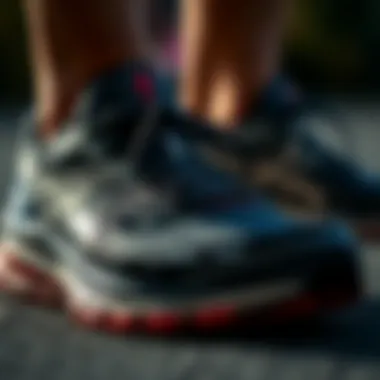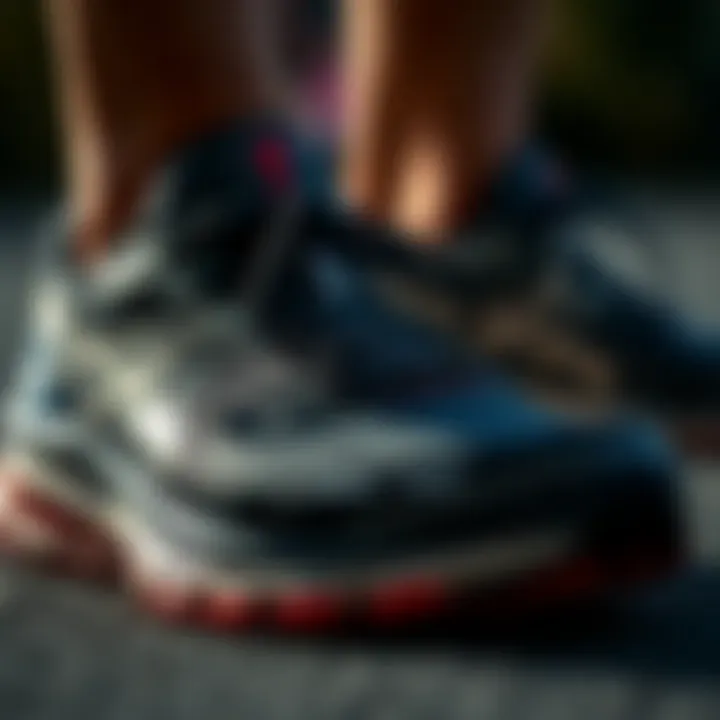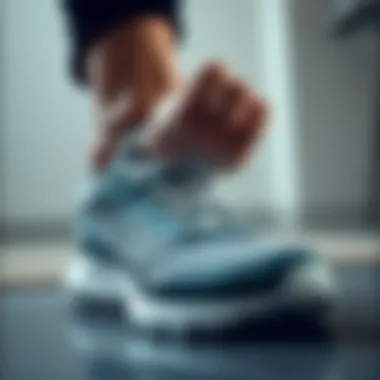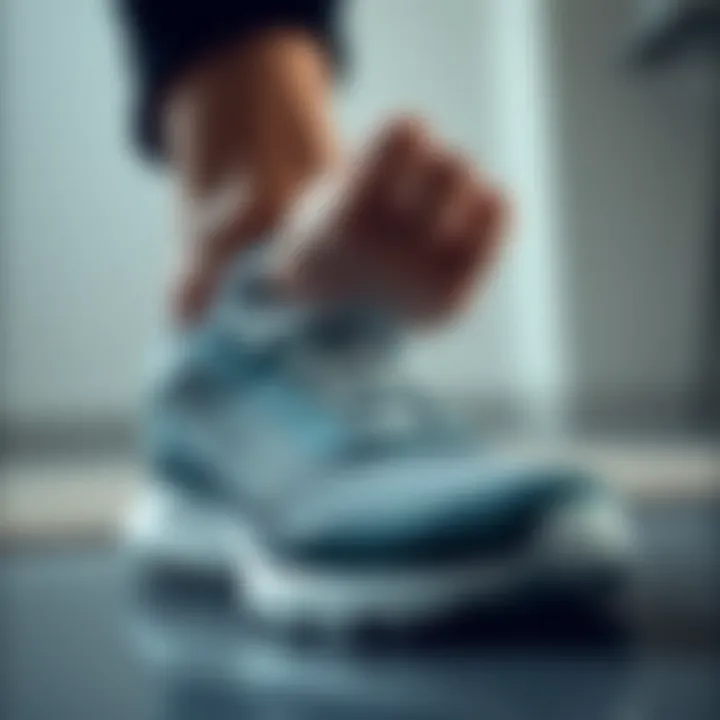The Ultimate Guide to Choosing Running Shoes


Intro
When it comes to running, the right pair of shoes can make all the difference. Choosing appropriate footwear isn't just about aesthetics or standing out at the local running club. It directly affects how you feel during your runs, your injury risk, and performance.
The variety of running shoes available today can leave anyone baffled. Some are designed for concrete jungle trails, while others hug gravel paths and some may even brave the winter snow. This article dives into every detail you need to consider when picking the best running shoes, ensuring that you don’t just grab the first pair that catches your eye.
Health Benefits
Running is not merely a hobby; it's an effective way to ward off numerous health issues. When fitting the right shoes, you unlock both physical and mental benefits. Let's dissect these two vital aspects.
Physical Health Benefits
Selecting the right running shoes helps prevent injuries like sprains, strains, and even stress fractures. These injuries often stem from shoes that are unsuitable for your foot type or running style.
Good shoes offer:
- Arch support, which stabilizes your foot and enhances balance.
- Cushioning, allowing easier impact absorption, reducing the stress on joints.
- Fit, as shoes that adequately hug your feet are less likely to cause blisters or calluses.
With the correct shoes, you can improve your performance. You'll likely find yourself running longer distances or even faster paces without discomfort.
Mental Health Benefits
Running itself can be a mental boon, but having the right footwear amplifies that effect. Comfortable shoes can give you the confidence to increase your distance without fears of injury. It results in:
- Increased motivation, as you look forward to running instead of dreading the discomfort.
- Stress relief, as you can focus more on the rhythm of your breath and the sound of your surroundings rather than worrying about your foot pain.
- Enhanced mindfulness, allowing you to clear your head and concentrate on the present moment, which is often lost in our busy lives.
In essence, the right running shoes are not simply an accessory. They are foundational to a holistic approach to health and wellness, supporting both physical and mental well-being.
Practical Tips
Once you've acknowledged the health benefits, it becomes imperative to make an informed choice while shopping for running shoes.
- Understand your gait: Pay attention to how your foot strikes the ground. Are you a heel-striker or midfoot striker? This will guide your choice.
- Identify the terrain: Running paths differ significantly. Ensure you select shoes tailored for the environment—trail shoes for rugged paths, and road shoes for smoother surfaces.
- Try before you buy: Always try on shoes with the socks you plan to run in, and don't hesitate to walk or jog a bit in the store to assess comfort.
Good luck in selecting your next pair of running shoes! The journey may seem overwhelming, but with this guide and a clear understanding of the factors involved, you'll be well on your way to a satisfying running experience.
"Investing in a quality pair of running shoes is investing in your health and happiness."
For more intricate details on running shoes, you might benefit from resources like Verywell Fit, and Runner's World which offer comprehensive insights.
Start your journey to better performance—with the right shoes, you're already halfway there.
Prolusion to Running Shoes
When diving into the world of running, the conversation about footwear quickly rises to the forefront. Running shoes are not just accessories; they're fundamental to the way we engage with the activity. Good shoes can mean the difference between enjoying a run and feeling every inch of the pavement with discomfort or pain. This makes understanding how to choose running shoes of utmost importance for runners of all levels.
Understanding the Importance of Proper Footwear
The significance of quality running shoes is often understated. Many might think that any athletic shoe will do, but they couldn’t be any more wrong. Shoes tailored specifically for running are engineered to meet the unique demands of forward motion, such as cushioning to absorb impact and lightweight materials for agility.
Here are some key reasons why proper footwear is crucial:
- Injury Prevention: Poorly fitted or unsuited footwear can lead to injuries like shin splints and plantar fasciitis. Wearing shoes that provide the right support helps keep these issues at bay.
- Enhanced Performance: Properly designed running shoes can improve your stride and efficiency. When your feet are properly supported, every step becomes more powerful and less taxing.
- Comfort and Endurance: The right pair helps to minimize blisters and discomfort, allowing for longer and more enjoyable runs, which can positively affect mental wellbeing and motivation.
Understanding the nuances between different types of running shoes can empower runners to make informed decisions that align with their personal needs and goals.
The Impact of Technology on Running Shoes
In recent years, the innovation in running shoe technology has revolutionized how we think about footwear. With the advent of new materials and designs, running shoes have advanced in ways that were unimaginable a decade ago. Manufacturers are investing heavily in research to develop shoes that enhance performance while minimizing injury risk.
Some notable impacts of technology on running shoes include:
- Lightweight Materials: Advances in synthetic fabrics mean shoes are lighter than ever, helping runners feel less burdened during long distances.
- Smart Cushioning Systems: Many brands now offer energy-return cushioning technologies like those seen in shoes from Hoka One One or Nike’s ZoomX, designed to optimize energy efficiency with each step.
- Foot Shape Adaptation: Some shoes employ adaptive fit technologies, ensuring the shoe wraps comfortably around the foot’s shape, improving fit without compromising support.
These technological advancements not only reflect a commitment to runner safety and comfort but also indicate a broader movement toward improving the performance of athletes at all levels.
"Investing in the right running shoes is like investing in your health—it's an essential step for any serious runner."
In summary, understanding the importance of proper footwear combined with appreciating the impact of modern technology offers a solid foundation for making informed choices in the world of running shoes. As we delve deeper into the specific components and types of footwear, the knowledge gleaned here will guide one towards enhanced running experiences.
Anatomy of a Running Shoe
Understanding the anatomy of a running shoe is crucial for making an informed choice that goes beyond aesthetics. Each element of the shoe serves a specific purpose, enhancing performance, comfort, and even injury prevention. The interplay between materials and design determines how a shoe interacts with your foot during a run. By unpacking the intricacies of running shoe construction, we can appreciate why certain features matter and how they contribute to our running journeys.
Upper: Materials and Design
The upper part of a running shoe serves not just to keep the shoe on your foot, but also to provide essential support and breathability. It's typically made from a combination of synthetic materials, mesh, and sometimes leather. Each material choice affects your comfort and fit. Mesh, for instance, is lightweight and facilitates airflow—perfect for those long summer runs where your feet might get too hot. On the other hand, synthetic materials can often provide a snugger fit, which is beneficial for runners who prefer a more secure feel.
- Breathability: A well-ventilated upper minimizes moisture, preventing blisters and creating a more comfortable experience.
- Support: The design can incorporate additional features like overlays or reinforced stitching that improve stability, especially around the heel and midfoot.
- Flexibility: An intelligently designed upper allows for natural foot movement as you transition from heel to toe, maximizing energy efficiency.
Finding the right upper can be a game-changer. Brands often offer various styles tailored to specific running needs, from casual joggers to competitive athletes. Ultimately, the ideal upper will balance support, comfort, and breathability to enhance your running efficiency.
Midsole: Cushioning Variations
Arguably the most vital component of any running shoe, the midsole primarily dictates the shoe's cushioning, bounce, and stability. Various materials like EVA (ethylene-vinyl acetate), polyurethane, or newer, proprietary foams like Nike's React or Adidas' Boost have marked advancements in cushioning technology over the years.
- Cushioning: Some runners prefer a plush feel, which cushions impacts, while others may lean towards a firmer midsole that offers better ground feedback.
- Energy Return: Innovations in midsole technology have led to the emergence of energy-return systems that aim to convert impact energy into propulsion, enhancing performance with each stride.
- Stability Features: Stability shoes often incorporate firmer foam on the inner side of the midsole to prevent overpronation—a common issue for many runners.
When evaluating midsoles, consider your running style and preferences. Your choice in cushioning can directly affect your overall performance and comfort levels, which is why testing different styles is so essential.


Outsole: Grip and Durability
The outsole is the shoe's first line of defense against the ground—its design and materials affect everything from grip to longevity. Outsoles are predominantly made from rubber, and their texture and tread pattern considerably influence traction and durability.
- Grip: The right tread pattern enhances grip on varying surfaces—from wet roads to rugged trails—preventing slips and ensuring safety in different conditions.
- Durability: A higher quality rubber compound can resist wear and tear, extending the shoe's life and maintaining performance over time.
- Flex Groove Design: Strategically placed flex grooves can enhance flexibility, promoting a more natural foot motion and improving the overall running experience.
In sum, the outsole should be tailored to the environments you plan to run in. A shoe built for road running, for example, will differ significantly from one meant for trail use, illustrating how critical it is to consider your typical running conditions when selecting shoes.
"A well-structured running shoe can mean the difference between a pleasant run and a painful experience. Not only do various elements serve specific functions, but together, they create the foundation for your journey to better performance."
Ultimately, understanding the anatomy of running shoes empowers you to make a more educated choice. Each component plays a significant role, and prioritizing your personal fit and preferences will elevate both comfort and performance on the road or trail.
Choosing the Right Fit
Choosing the right fit for running shoes is not just a matter of comfort; it fundamentally impacts performance and injury prevention. A shoe that fits poorly can cause blisters, calluses, or even long-term issues like plantar fasciitis or shin splints. To avoid these pitfalls, it's critical to consider several factors that contribute to the perfect fit.
First and foremost is the overall size of the shoe. Many runners assume their shoe size remains constant, but this isn't always the case. Feet can expand with age or due to physical activity, so it's essential to measure your feet regularly. Beyond just the number on the tag, the fit involves understanding how the shoe feels during various phases of a run, including tightness, slip, and general comfort.
Another aspect to consider is the width of the shoe. Runners often have varying widths, and a standard width may not suffice. Some brands offer options like wide or narrow models. Trying on different widths ensures that the shoe is snug but not restrictive. Your toes should have a little wiggle room without feeling cramped.
In addition, having a good fit around the heel prevents slipping, which can lead to friction and blisters. A locked-in heel aids in delivering that needed stability and propulsion during runs. A proper fit enhances your confidence to tackle different terrains and distances. In essence, a well-fitted running shoe should feel like an extension of your foot, allowing you to achieve your best without distractions or discomfort.
Measuring Your Foot Correctly
Measuring your foot correctly is the cornerstone of finding the right running shoe. Surprisingly, many people skip this vital step, leading them to select shoes that don’t truly fit. Here’s a step-by-step approach to get it right:
- Gather Materials: You’ll need a piece of paper, a pencil, and a ruler.
- Trace Your Foot: Place a piece of paper on the floor, stand on it, and trace around your foot. Make sure you’re standing straight and applying your full weight.
- Measure the Length: Use the ruler to measure from the tip of your longest toe to the back of your heel. Note down the measurement.
- Measure the Width: Similarly, measure the widest part of your foot.
- Use a Size Chart: Compare your measurements to the specific brand's size chart, as sizing can vary significantly across brands.
Doing this will give you a clearer idea of what you need. If you often find that your shoes are too tight or loose, it could very well be because you haven't measured correctly. Keep in mind that foot size can fluctuate throughout the day, so it's best to measure your feet in the evening when they’re slightly swollen.
Understanding Foot Shape and Arch Type
Every foot is unique, and understanding your foot shape and arch type is fundamental when selecting running shoes.
Foot Shape: Generally, feet can be categorized into three shapes: neutral, wide, and narrow. Neutral shapes tend to fit a standard shoe, while wide feet may require brands that offer wider options. A narrow foot will need a snugger fit to avoid slippage.
Arch Types: The arch of your foot plays a significant role in how weight is distributed across your foot. There are three arch types – high arches, medium arches, and flat arches. Runners with high arches might benefit from more cushioning to absorb impact, while those with flat feet may need stability or motion control shoes to prevent overpronation.
"A shoe should feel like a tailored fit, not like a cast."
A simple way to identify your arch type is the wet test. Wet your foot and step on a piece of paper. The imprint left can guide you in understanding your arch type. Knowing whether you’re a neutral, overpronator, or supinator can dramatically improve your running efficiency and comfort.
Trying Before You Buy
The adage "try before you buy" rings particularly true when it comes to running shoes. Sporting goods stores often have staff trained to assist you in finding a fit that works.
Here’s what you should do:
- Bring Your Own Socks: Wear the socks you plan to run in. This small detail can alter the fit of the shoe.
- Walk and Run: Don’t just stand in the shoes; walk around the store, and if possible, jog a short distance. Pay attention to how the shoe feels and whether there’s any discomfort.
- Check for Breathing Room: Your toes should have space at the front. A good rule of thumb is to have about a thumb's width between your longest toe and the end of the shoe.
- Assess Stability and Comfort: Make sure the shoe provides enough support without being overly stiff. A balance of flexibility and stability is key.
By taking the time to try on shoes properly, you’re investment in your comfort and performance will pay off. Remember, the right shoe can make or break your running experience, so don't skimp on this important part of the process.
Different Types of Running Shoes
When it comes to running, the type of shoes worn can really make or break a runner's experience. Picking the right kind of running shoe is essential for not only performance but also for comfort and injury prevention. Each category serves distinct purposes and caters to various running styles and environments. Understanding the differences helps runners avoid pitfalls that can lead to discomfort or even injury. Let’s take a closer look at several main categories of running shoes, and see why knowing their characteristics matters.
Neutral Running Shoes
Neutral running shoes are designed with a simple philosophy in mind: to provide a smooth and natural running experience. These shoes cater to runners who have a neutral foot strike or minimal pronation. They often feature ample cushioning to absorb impact, allowing for a soft landing.
Key Aspects:
- Cushioning: Enhanced cushioning helps protect the feet during high-impact activities.
- Weight: Typically lighter than their stability counterparts, neutral shoes can make for a more responsive run.
- Flexibility: Usually more flexible, allowing for a natural toe-off.
Runners typically appreciate these for their comfort on longer distances. However, one must be cautious; using neutral shoes for overpronation can lead to injuries. Think of them as a breezy day—perfectly pleasant, but reliant on conditions remaining favorable.
Stability Running Shoes
Stability running shoes are engineered to offer support and help combat excessive pronation. They are often heavier than neutral shoes because they incorporate additional material to help guide the foot.
Key Aspects:
- Support Features: Many come with a medial post or denser foam on the inside to control internal movement.
- Cushioning Balance: They still provide cushioning but not of the same extreme as neutral shoes; the aim is to strike a balance between stability and comfort.
- Durability: Often built to withstand heavier impacts due to the added support structure.
If you’re the type of runner whose feet roll inward, these could be your go-to. They act like a sturdy ship in choppy waters, keeping you steady even through the rougher patches.
Trail Running Shoes
For those who prefer to run off the beaten path, trail running shoes come into play. These shoes are built to handle uneven terrain and often include features that enhance grip and protect the foot.
Key Aspects:
- Tread Patterns: Aggressive outsoles with deep lugs for improved traction on soil, rocks, or wet surfaces.
- Protection Elements: Many models incorporate toe caps and reinforced sides to shield from trail hazards.
- Water Resistance: Some variations even offer waterproofing for those rainy runs or riverside jogs.
Trail runners can appreciate the mix of ruggedness and support—these shoes act like trusty hiking boots, bridging the gap between running and exploring. If your runs often bring you face to face with nature, consider them a necessary tool in your kit.
Minimalist Running Shoes
Minimalist shoes have carved out a niche for those that seek a closer connection with the ground. They reflect a philosophy of letting your foot’s natural mechanism dictate your stride, often characterized by near-zero drop from heel to toe.


Key Aspects:
- Lightweight Design: Often extremely lightweight, aiming to mimic barefoot running.
- Flexibility: High flexibility allows for natural foot movement and freedom of motion.
- Pacing Awareness: These shoes promote a forefoot striking technique, which may reduce injury but can also lead to fatigue if the body isn’t conditioned.
Keep in mind that while they offer freedom and a unique feel, stepping into them without proper transition could lead to discomfort. Just like running on a tightrope, one requires a measured approach to balance safety with exhilaration in minimalist shoes.
Ultimately, the choice between these different types of running shoes comes down to individual needs, preferences, and foot mechanics. A well-informed decision can greatly enhance your running experience and contribute to long-term health.
Top Brands for Running Shoes
When it comes to selecting running shoes, the brand can often be as significant as the shoe’s technical specifications. Top brands for running shoes not only bring a renowned reputation but also years of research, innovation, and user feedback to the table. The emphasis on brand becomes especially crucial when considering how different companies have tailored their products to meet various needs of runners, from elite athletes to casual joggers. Understanding the strengths of these brands can guide consumers towards making choices that best align with their running style and personal comfort preferences.
Nike: Innovation and Performance
Nike has always positioned itself as a frontrunner in the athletic footwear market. The brand’s blend of cutting-edge technology with performance-oriented designs gives runners the tools they need to push their limits. For instance, the Nike Air Zoom series utilizes air cushioning to provide responsive energy return, ensuring that each step feels light and springy.
Moreover, the incorporation of features like Flyknit uppers allows for breathability and flexibility, conforming snugly to the foot without sacrificing support. Nike's commitment to innovation has led to a continuous evolution of their products, making them a go-to choice for many serious runners.
"Nike doesn’t just sell shoes; they sell an experience that encourages every runner to hit the pavement with confidence."
Adidas: Comfort Meets Style
Adidas has carved a niche in combining aesthetic appeal with exceptional comfort. They’re well-known for their Boost technology, which offers phenomenal cushioning. This technology helps absorb impact, making longer runs feel more manageable. The Adidas Ultraboost is a testament to such innovation, receiving acclaim not only for its performance but also for being fashionably versatile.
Additionally, Adidas emphasizes sustainability through Primegreen materials, showing that style and environmental responsibility can go hand in hand. Many runners appreciate the brand's collaborations and trendy designs that can easily transition from a workout to a casual outing.
Asics: Stability and Support
Asics is celebrated for its well-researched designs aimed at enhancing stability and support for runners with specific needs. For many, the Gel-Kayano series stands as a beacon of reliability, especially for overpronators needing extra support. With its gel cushioning system, Asics helps in minimizing shock during impact, making it easier on joints without compromising performance.
This focus on biomechanics and personalized fit ensures that runners can find their ideal match. Asics consistently makes strides in researching foot dynamics, which pays off by offering a tailored experience that resonates with both amateur and professional runners alike.
Brooks: Tailored for Runners
Brooks stands out in the field by prioritizing the needs of runners above all else. Their slogan, "Run Happy," encapsulates their mission to ensure a comfortable running experience. The Brooks Ghost series, known for its plush cushioning and smooth ride, thrives on accolades from running communities.
Moreover, Brooks delves into personalization through their Fit by Brooks initiative, providing options that cater to unique foot shapes. This attention to runners' specific needs solidifies Brooks as a reliable option for those seeking both comfort and performance.
Saucony: Performance and Fit
Saucony takes pride in delivering shoes that enhance performance while ensuring a snug fit. The Kinvara model is particularly well-regarded, gaining popularity among competitive runners for its lightweight design and responsive nature. Saucony employs advanced technology like PWRRUN to create a springy feel in every step.
Their relentless commitment to fit and comfort means that runners can enjoy longer distances without facing discomfort. With a variety of widths available, Saucony truly caters to a wide range of runners, making them an appealing brand in the running community.
In summary, each of these top brands brings distinct advantages, ensuring that whether runners prioritize innovation, style, stability, or performance, there’s a shoe that meets their needs. With the right brand backing your choice, you'll not only be equipped for the road ahead but also inspired to reach new personal records.
Reviewing Popular Models
When it comes to selecting the perfect pair of running shoes, reviewing popular models can be an enlightening journey. The landscape of footwear is constantly evolving, with brands embracing new technologies and designs to enhance performance and comfort. This section will shed light on some of the standout shoes available today, emphasizing how they cater to various running styles and preferences.
Knowing what’s trending often provides a clearer picture when choosing running shoes. Each model featured in this guide is backed by a wealth of user feedback, expert testing, and innovative features that set them apart. From comfortable daily trainers to specialized shoes for racing, it’s essential to consider not only the features of each shoe but also their suitability to individual needs and styles.
Nike Air Zoom Pegasus
The Nike Air Zoom Pegasus has become a go-to option for many runners. Its versatility makes it shovel-ready for various workouts, from long-distance runs to speed training. The shoe boasts a thick midsole withZoom Air units that deliver responsive cushioning. Runners often report that it strikes a fine balance between softness and stability, crucial for those who log heavy miles.
But it's not just about comfort. The Pegasus is also equipped with a durable outsole that holds its own on both paved surfaces and trails. Having a shoe that's ready to transition between different terrains widens the choice of routes on any given day. In a nutshell, if you seek a reliable companion for your runs, the Pegasus is a stable investment.
Adidas Ultraboost
When we talk about comfort, the Adidas Ultraboost stands a head taller than many competitors. This model features a unique Boost foam that provides immense energy return with each stride, making your runs feel easier, longer, and, ideally, more enjoyable. The knit upper wraps closely around the foot, providing an almost sock-like feel that many users have praised for its snug fit.
However, it’s not just about plushness. The Ultraboost also offers a solid grip courtesy of its Continental rubber outsole. What’s great is that many runners describe this shoe as perfect for both easy runs and fast-paced workouts. Adidas tapped into a successful blend of performance and style, allowing runners to transition from the track to a casual outing without missing a beat.
Asics Gel-Kayano
For those who require extra support, the Asics Gel-Kayano becomes the litmus test. Renowned for its stability features, this shoe is particularly aimed at overpronators. The Gel cushioning system, along with the Dynamic DuoMax support, provides excellent control and comfort.
Runners frequently commend its durability, especially for long-distance endeavors where fatigue can lead to poor form. The Kayano excels in both comfort and protective feel. It makes an impressive road running shoe for serious athletes who prioritize support while tackling challenging distances. With most reviews shining a spotlight on its performance during long runs, it surely asserts its place in the shoe hall of fame.
Brooks Ghost
Brooks has been around the block a few times, and the Ghost series reflects their deep understanding of runners' needs. This model is classified as a neutral running shoe, making it well-suited for those who need balanced cushioning without the added support of stability shoes.
The Ghost typically features a soft, plush midsole that provides a great feel with every step. One of the standout attributes is the segmented crash pad that adapts to your foot strike, improving the transition through the gait cycle. Users regularly appreciate its adaptability for various workout intensities, asserting that this shoe is a trustworthy partner, whether one is sprinting or jogging.
Saucony Kinvara
The Saucony Kinvara is often recognized for its lightweight build and agility. Aimed at runners who appreciate a more minimalist approach without sacrificing cushioning, the Kinvara promotes a natural running style.
The shoe’s ComfortLite EVA sockliner helps with moisture management, ensuring your feet stay dry during grueling runs. It also features a flexible and breathable upper, which contributes to the overall lightness and swift feel. Many runners share that this shoe feels almost like an extension of their foot, making it a favorable choice for race days or tempo runs. If speed is your game, the Kinvara is often considered a fitting companion.
"Choosing the right running shoe can transform your performance and enhance your overall running experience. Take the time to find what fits your unique style."
Exploring these popular models gives budding runners a solid start for selecting shoes designed for both comfort and performance. Each of these options caters to different preferences and running styles, making it easier to make an informed decision that balances style with functional needs.
The Role of Running Style
Every runner adopts a unique approach to putting one foot in front of the other. Understanding this personal style can greatly influence the shoe selection process. Each type of running stride can cause differing impacts on the foot, thereby affecting which shoes will provide optimal support and comfort. Choosing the wrong shoe can lead to discomfort or even injury, making it vital to consider running style as an essential aspect of your running shoe choice.


Heel Strikers vs. Forefoot Strikers
Running styles typically fall into two main categories: heel strikers and forefoot strikers. A heel striker typically lands on the heel of the foot first, which is common among new and casual runners. This style can result in a higher impact shock being transmitted through the legs if not cushioned adequately. On the other hand, forefoot strikers land on the ball of their foot, which tends to distribute impact more evenly and can lead to a more efficient running form.
- Heel Strikers: They often require shoes with superior cushioning to absorb the shock. A shoe with a padded heel is essential to minimize impact.
- Forefoot Strikers: These runners may benefit from shoes that offer less drop from heel to toe, permitting a natural stride while encouraging better propulsion.
Recognizing whether you fall into one of these categories can guide your choice, helping you select a shoe that enhances your running experience while protecting against potential injuries.
Identifying Your Running Technique
To select the right pair of shoes, it's beneficial to first identify your specific running technique. This can usually be determined through observation or more formal methods such as gait analysis. Consider these tips for a practical assessment:
- Watch Your Foot Strike: Video yourself running to observe how your foot lands.
- Pay Attention to Wear Patterns: Check the wear on your current shoes. Does it show excessive wear on the heel, the outside, or the inside?
- Consider Professional Analysis: Many running stores offer gait analysis to help identify your running technique, which can provide invaluable insights.
This detailed understanding will not only inform your shoe selection but also enable you to adjust your running form for better performance.
Choosing Shoes Based on Style
Once you understand your running style and technique, it’s time to choose the right shoes. Not all shoes are created equal; they vary in structure, support, and cushioning based on different running styles.
- Shoes for Heel Strikers: Look for options with considerable cushioning and stability features. Brands often incorporate technology aimed at shock absorption, ensuring comfort during every stride.
- Footwear for Forefoot Strikers: These should prioritize lightweight materials and a lower heel-to-toe drop to enhance speed and agility. A flexible midsole can promote a more natural foot movement.
- Bottom Line: Remember that digging deep into your style is key. Each run should feel effortless, where the shoe feels like an extension of your body rather than a cumbersome accessory.
"The right pair of running shoes can transform your experience from painful laps around the block to achieving personal bests and chasing your running goals."
Maintaining Your Running Shoes
Running shoes are not just tools; they are investments in your health and performance. Proper maintenance can extend their lifespan and ensure they function as intended. A well-kept pair of shoes not only protects your feet but also enhances your running experience. It bears repeating that neglecting your shoes can lead to unwanted wear, which may affect your performance and, more importantly, your health.
Cleaning Techniques for Longevity
Keeping your running shoes clean is essential to their longevity. Not only does regular cleaning help in aesthetics, but it also preserves the materials from degrading prematurely. Here are some useful tips:
- Remove Dirt and Debris: After each run, use a soft brush or cloth to wipe away mud and dirt. It's easier to do this while the debris is still damp.
- Hand Wash: If your shoes need a deep clean, use lukewarm water mixed with mild soap. A cloth or soft-bristled brush works well for this. Avoid submerging them completely, as this can damage the materials.
- Air Dry: Always let your shoes air dry after washing. Avoid direct sunlight and heat sources since they can warp the shoe.
- Remove Insoles and Laces: Clean the insoles and laces separately. Laces can usually go in the washing machine, but ensure they’re in a mesh bag to prevent tangling.
"Regular upkeep of running shoes is crucial; a few minutes can save you from a host of problems down the road."
These practices can help your shoes look good and perform better over time. They are especially vital if you tend to run frequently or in harsh conditions.
Recognizing When to Replace
Knowing when to replace your running shoes is key to maintaining both performance and preventing injuries. Signs can be subtle, or they can be quite apparent. Here are some indicators:
- Mileage: Many shoes can effectively last anywhere from 300 to 500 miles, depending on the type and running surface. Keeping track of your miles can provide a good benchmark.
- Visual Wear: Uneven wear on the outsole or tears in the upper material signal it's time for a change. If you notice significant changes in the tread pattern, that’s another strong clue.
- Loss of Cushioning: Over time, the cushioning in your shoes breaks down. A simple test is to press down on the midsole with your thumb. If it doesn't bounce back or feels excessively firm, it's probably time to shop for a replacement.
- Discomfort or Pain: If you're experiencing new aches or discomfort during or after runs, your shoes might not be providing adequate support anymore. Keep an ear out for what your body is telling you.
By paying attention to these signs, you can ensure that your running shoes continue to support you as you hit the pavement or trails. The right maintenance routine combined with timely replacements will ultimately keep your running healthy and enjoyable, paving the way for improved performance.
Environmental Considerations
In today's world, where conversations about sustainability have become nearly as prevalent as those around fitness and health, the topic of environmental considerations in running shoes cannot be overlooked. Running is sometimes viewed as a personal endeavor, yet it contributes to a broader ecological footprint. As consumers become more aware of their choices, understanding how running shoes impact the environment plays a significant role in making informed purchases. Choosing shoes made with eco-friendly materials can make a real difference, not only in your performance but also for the planet.
Sustainable Materials in Footwear
An upsurge in consciousness about the planet has caused manufacturers to rethink the materials used in their shoes. Traditional production methods often rely on synthetic materials derived from petroleum, which has a substantial carbon footprint. However, many brands are now exploring alternatives. For instance, introducing shoes made from recycled plastics helps reduce waste in oceans while also providing comfort and durability to runners.
Another compelling option is the use of natural materials, such as organic cotton or hemp. These options lower environmental impact during production, contributing to a more sustainable running experience. Moreover, implementing bio-based materials, which decompose more naturally than synthetic options, aligns with the increasing push towards sustainability.
Here are several benefits of choosing sustainable materials in footwear:
- Reduced Carbon Footprint: Fewer emissions are produced during the manufacturing process of sustainable materials.
- Biodegradable Elements: Natural components are easier to break down after disposal, reducing long-term waste.
- Support for Ethical Practices: Many brands employing eco-friendly materials adhere to ethical labor practices.
The Impact of Running Shoes on the Environment
One might think that a simple pair of running shoes wouldn’t make much of an environmental impact. However, consider the entire lifecycle of the shoe—from production to disposal. According to research, the production of one pair of shoes can generate around 30 pounds of carbon dioxide. As runners, choosing footwear wisely has a larger ripple effect.
The overarching concern isn’t just about emissions; it’s also about waste. Many shoes end up in landfills where they can take decades, or even centuries, to decompose. Some brands have implemented take-back programs where old shoes can be returned, recycled, or repurposed. Investing in brands that are committed to environmental stewardship is another step towards minimizing your ecological footprint.
To underscore the gravity of this topic, consider this:
"Every step you take not only shapes your fitness journey, but also the world around you. Choose wisely."
When selecting running shoes, it’s advisable to consider their environmental implications. By opting for brands that utilize sustainable practices and materials, you’re not only fueling your running journey but also nurturing the environment. With better choices today, we foster a healthier planet for future generations. Remember, every little bit counts; the combined effect of thoughtful consumerism can lead to larger shifts in the industry.
For those wanting to delve deeper, resources such as Wikipedia and National Geographic provide insights into sustainability and its relevance in today’s world.
Finale
Selecting the right running shoes is more than just a matter of style or brand loyalty; it is a crucial decision that can affect performance, comfort, and even health. This article has explored various aspects of running shoes, from their anatomy to environmental considerations. Let's dig into why the conclusion is vital in encapsulating the key insights we’ve discussed.
Summarizing Key Takeaways
First and foremost, the fit of the shoe is paramount. An ill-fitting shoe can lead to discomfort and injuries. We highlighted the importance of understanding one's foot shape and arch type, ensuring that you know your specific needs when it comes to footwear.
Furthermore, the materials and technology in running shoes play a significant role in enhancing the running experience. Considerations such as cushioning properties, breathability, and durability can impact not just how you run but how you recover afterward. We viewed how brands like Nike, Adidas, and Asics integrate technology into their shoe lines to cater to various needs, making informed choices easier.
Another key point is understanding the different types of running shoes available. Whether you’re a trail runner, a casual jogger, or someone who prefers minimalist shoes, matching your running style with the appropriate shoe type cannot be overstated. Each design has its unique benefits, fostering efficiency in performance.
Lastly, we touched upon the environmental impact of running shoes. As eco-consciousness rises, the use of sustainable materials is becoming more prevalent in the industry. This consideration not only benefits the planet but can also be a selling point for consumers looking to make more responsible choices.
Encouraging Thoughtful Purchase Decisions
- Make It Personal: Use the factors discussed as a framework. Whether it’s measuring your foot correctly or trying on shoes at the end of the day when your feet are at their largest, be thorough.
- Stay Informed: Keep up with innovations in footwear technology. New solutions are released regularly, so what worked last year may not meet your current needs.
- Consider Sustainability: Remind yourself of the impact your choices have on the environment. Research brands that prioritize eco-friendly practices, thus aligning your purchase with your values.
"The shoe you wear today can either support your stance or lead you to stumble tomorrow. Choose wisely."
By synthesizing all these elements, the conclusion not only wraps up the discussion but also empowers you to step forward with confidence in your running shoe selection. For additional reading on running shoes and their impacts, consider checking resources like Wikipedia and Britannica. Keen to learn more or share your experiences? Engage with communities on Reddit or follow discussions on platforms such as Facebook.
In the end, investing a little time and thought in your running shoe selection can make all the difference in your running journey.















